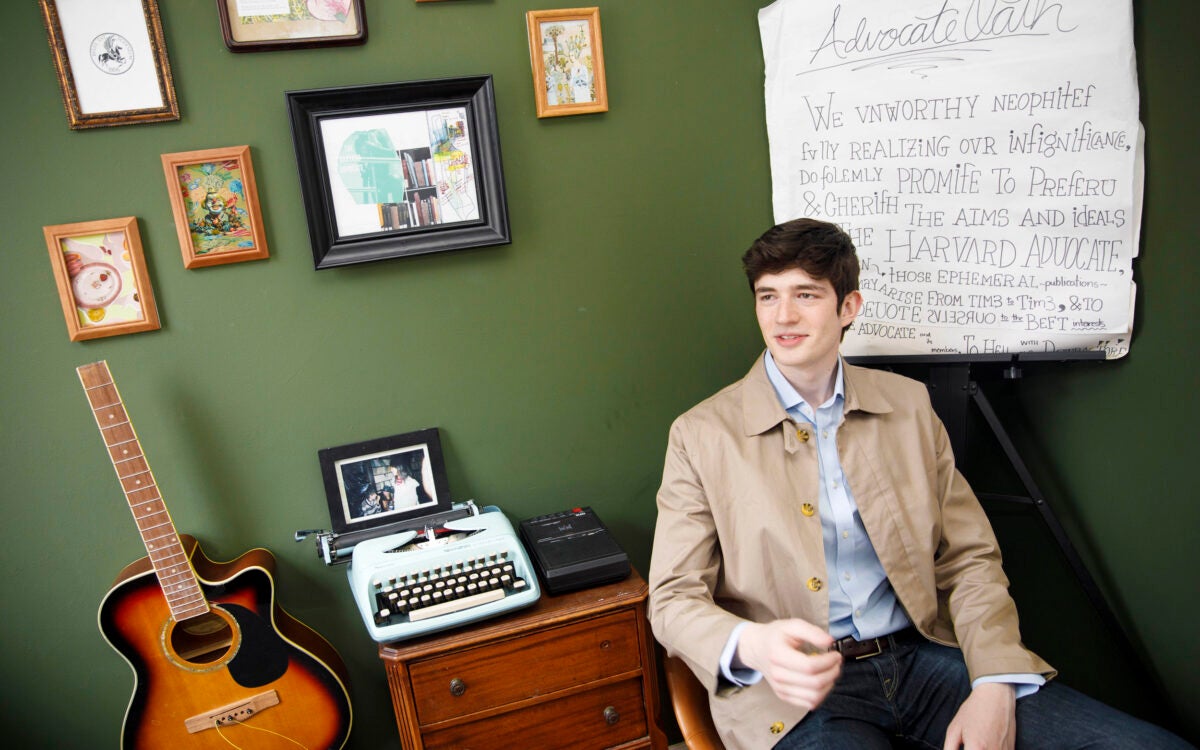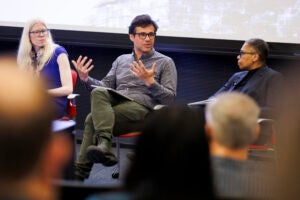
A podcast where the life of the mind meets everyday life. Join Harvard Gazette writer Samantha Laine Perfas as she convenes experts from different disciplines for conversations about issues that affect people in real, tangible ways. Produced by Harvard University. Find us on Apple Podcasts, Spotify, and YouTube.
Featured Episode
In this episode of the “Harvard Thinking” podcast, experts explain why pandemic learning losses run deeper than many parents realize.
Transcript
Thomas Kane: A lot of parents misperceive how much students have lost. They see kids are back in school and they’re thinking everything’s back to normal. And honestly, that has been one of the biggest things hampering the recovery: parents thinking things are fine now that kids are back in school.
Samantha Laine Perfas: American schools took a big hit during the pandemic. On average, they lost half a grade level in math and a little less than that in reading. Some schools have come back, but many others have not, and some are in even worse shape. Other problems have also cropped up, like a surprising rise in absenteeism that spans geography and income. So what happens now?
Welcome to Harvard Thinking, a podcast where the life of the mind meets everyday life.
Today, I’m joined by:
Kane: Tom Kane. I’m a faculty director of the Center for Education Policy Research here at Harvard.
Laine Perfas: He works with school districts and state agencies to help them evaluate programs and policies. Since the pandemic, a lot of his research has focused on gains and losses in education. Then:
Heather Hill: Heather Hill. I am at Harvard GSE. My research focuses on mathematics teaching. I spend a lot of time in classrooms, which is one of my favorite things to do.
Laine Perfas: She also co-directs the teacher education program at GSE, Harvard’s Graduate School of Education, and helps prepare teachers for the classroom. And finally:
Stephanie Conklin: Stephanie Conklin. I’m a math teacher at Colonie Central High School.
Laine Perfas: She’s also a New York State Master Teacher and a graduate of GSE. She serves on the faculty at the University of Albany.
And I’m Samantha Laine Perfas, your host and a writer for The Harvard Gazette. And in this episode, we’ll explore what’s happening in our schools as they try to regain pandemic learning losses.
It’s not a surprise that education took a big hit during the pandemic, but I think there’s been some surprise regarding its lingering effects. I’d love to start the conversation with where things stand now. Maybe, Tom, you can start by talking a little bit about your research in this area.
Kane: Sam, as you said, it was not surprising that students lost ground during the pandemic. But I think many were surprised by just the magnitudes of the losses, especially in many high-poverty school districts in the U.S. Remember March of 2021, when the American Rescue Plan passed, people were sort of hoping that online learning was, maybe, 80 percent as good as in-person learning. We learned subsequently that many districts lost much more than 20 percent of their typical learning during that school year. Now, as a country, we lost about half of a grade level in math and we made up about a third of that. We lost about a quarter of a grade level in reading and we made up about one quarter of that. So we still have a ways to go, and that is on average. There are many districts that are much farther behind than that, like more than a grade level behind.
Laine Perfas: Yeah. I actually wanted to ask you about how the average somewhat hides the greater gaps that are at play. Because when I was looking at some of your research, I was seeing that some school districts are pretty much back to where they were, if not doing even better than before the pandemic. But other areas are significantly worse than pre-pandemic. What’s happening there and what districts seem to be recovering in a way that we would hope, and which districts are being left behind?
Kane: There was a lot of variation in the magnitude of losses, but two factors did play a role. One was high-poverty schools in every state were more likely to stay closed for longer. For instance, in Florida the average school went back sooner than the average school in Massachusetts. But still, even in Florida, the higher-poverty districts stayed closed for longer. And that was true in most other states. The second reason is that when schools closed the losses were larger for higher-poverty schools. Interestingly, in the places where schools did not close for long — like practically every school was closed in the spring of 2020 — but among those places that came back quickly in the fall of 2020, there wasn’t as much increase in inequality. High-poverty and low-poverty schools lost about the same amount of ground. It was in the places where schools were closed for half of the 2021 year or more, that’s where we really saw big differences in the magnitude of the losses.
Unfortunately, an untold story is that the higher-poverty districts in Massachusetts did the opposite of catching up between ’22 and ’23. They lost more ground. So Lynn, Massachusetts, is now basically two grade levels behind where they themselves were in 2019. Those gaps that existed before the pandemic are bigger now and all of the recovery in Massachusetts has been limited to the higher-income districts like Newton, Wellesley, Lexington. The higher-poverty districts like Lynn, Fall River, fell further behind between ’22 and ’23.
Hill: I think one of the issues about being home for a full year, which is what a lot of kids were in some cases in some of these urban districts, is that they forgot how to “student,” if you think about student as a verb. “Studenting” means paying attention, being engaged with your peers, being engaged with your teacher. When teachers came back they said, “Wow, these kids have forgotten how to be students,” and one of the things we saw pretty immediately was a rise in behavior issues on the part of kids. I would say from what I can tell, and I’d be curious what Stephanie thinks about this, I think those are worked out. But what teachers are also saying at this point is that the student engagement is not back yet.
Conklin: As Heather mentioned, when students came back to the classroom, besides just learning how to student, we also noticed that a lot of students’ skills in learning had really suffered. So for example, just students’ ability to retain facts and retain information, that is a real skill that we teach in schools. And then the other piece, too, to learning how to be a student, is being organized. Keeping track of eight classes for many of our students is a real struggle at the middle- and high-school level. And then not having had to do that for a year really made it even harder for students to access the curriculum. So many of us in education had to take a step back, not only reteach academic skills, we also have to teach, OK, how do you take notes in a math classroom? How do you use a calculator if you haven’t used it for a year?
Laine Perfas: It sounds like a big challenge has just been transitioning kids back to school. But another challenge that we’re seeing is actually getting kids back in the classroom in the first place. Can you talk about that and how absenteeism rates are really high right now?
Kane: Basically, chronic absenteeism rates have almost doubled from before the pandemic. By the way, when you yourself miss class, you miss more than a day. Obviously you miss that day you were gone, but the first day you’re back you’re maybe picking up 75 percent of what the teacher is saying. The second day you’re back you’re maybe picking up 80 percent of what the teacher is saying. But when you’re a teacher where 5 percent of kids are missing one day, but it’s a different 5 percent the next day, it’s a different 5 percent the next day. And then you’re trying to juggle and keep everybody going. It really becomes disruptive.
Laine Perfas: Are people still getting sick or is it just not seeing the value of attending school? What exactly is causing that huge increase in absenteeism?
Kane: I don’t think anybody really knows yet. At least part of it is likely due to the fact that I think parents are more aware of communicable diseases, whereas we might have sent our kid to school when they were coughing, now we might hesitate. But I think that is a small share of it. It’s more likely to be things like families have gotten out of their routines, kids, they’re more accustomed to being at home during a weekday of school.
Hill: I think parents are home more often as well at work from home, which takes the burden off of sending your kids to school because you’re like, “It’s not a big deal for you to be home.”
Conklin: For my students I take a picture of all my notes. I post my assignments online. Many of us educators got into a routine of making everything accessible for students, whether they’re in or out of the classroom. Now the positives to that are tremendous. I have students who will follow my notes on their iPad while taking notes with me in class, I have students if they’re absent a day here or there, they can catch up. However, I think that what that’s done is, if we have students who maybe are like, “Well, I’m not feeling great, I’m going to just stay home because Dr. Conklin always puts her notes online and I can catch up tomorrow.” I think families also have the same issue, but I did want to take Tom’s comment like a little bit farther about when a kid misses one day. In the educator perspective, we are not only trying to catch kids up for that day, teach them the content, but also from past things. Three years ago, they missed that content. So what I’m finding is it’s almost like whack-a-mole teaching. “OK, these five kids were out on Thursday. I need to catch them up on today’s lesson, but they still don’t know how to do these four topics.” But then I also have kids who I want to extend the lesson because they already know it. So we’re finding that teachers are not only scaffolding, differentiating lessons, it’s almost like too much for one human being to do, to have two to three different classrooms running in one classroom setting.
Hill: One of the things I think about teaching, which was already pre-pandemic a really difficult job for a lot of reasons, it’s become 20 percent harder. And that may not sound like, “Oh, it’s insurmountable.” But 20 percent harder day in, day out becomes really unsustainable. And I think one of the things that we’ve been seeing is increased teacher absence rates as well, which, paired with teacher shortages and sub shortages, puts schools in this really difficult position. So many of the schools that I’m in, it just feels very tenuous to be there because it erodes the social contract a little bit between students and teachers when you get that level of everybody’s absent and relationships can suffer.
Kane: So for all these reasons, it’s remarkable that between 2022 and 2023 kids did make up some of the ground. Students gained about .17 grade level in math, so that means that students learned roughly about 117 percent of what they would typically learn in math, which is remarkable. But a lot of that was paid for with federal dollars. People had extra resources to hire teachers’ aides or to hire tutors or expand summer school, and that federal money is expiring at the end of September.
Laine Perfas: I wanted to ask a little bit more about the relief dollars, because it seems like they helped. One, did they help, and was that a consistent benefit across the country? And then also, why is it ending in September if there’s clearly still pretty huge gaps that need to be bridged?
Kane: Remember, the American Rescue Plan, which provided this pot of federal money to school districts around the country, was passed in March of 2021; many schools were still closed. So that was before anybody knew how big the losses were going to be. And 90 percent of the money was sent directly to school districts. So basically 13,000 different school districts around the country were making up their own recovery plan. Some came up with better plans than others.
Unfortunately, the federal guidance on this was downright misleading because the federal law only required them to spend 20 percent on academic recovery. But a lot of districts like Lynn or Fall River that lost more than a grade level, there was no way they were going to be able to recover spending 20 percent of those federal dollars on academic recovery. There was simply no way. Imagine if at the beginning of the pandemic, the federal government said, “We’re not even going to try to come up with a vaccine. We’re going to send all the money out to local public health authorities and say, ‘You come up with your own solution.’” And that’s exactly what we did in education, is we put out $190 billion, 90 percent of it, directly to school districts. And then had them all figure out their own plans and some have made progress and some haven’t.
Conklin: I know, on the ground in my district, we’re spending a lot of money focusing on more teachers in classrooms. I teach an at-risk population. I’m math certified, but also special-ed certified, and I have a co-teacher. So there are two adults in my classroom at all times to support our special-ed students, all of our learners who are struggling, and so, at least in my district, I think we’ve been able to spend the money wisely, and we’ve been able to justify keeping those positions by changing how we’re funding other things. Now, when we talk about Lynn and other school districts in Massachusetts, they were probably underfunded to begin with. And so now they’re having to go back and figure out where can we put this money if it’s toward staffing, it’s toward students’ needs, in our high-poverty schools. How are we then going to justify keeping extra staff, which we know works? I’m in New York and high schools that I’m in touch with, our special-ed students who are consistently attending school because they have supports, they’re being really successful and they are catching up.
Kane: This is one place where I feel like both the federal government and states really dropped the ball during the pandemic. We had an opportunity to learn more about the efficacy of different strategies. The problem was we blew the opportunity to learn which of those strategies were most effective. So like in Stephanie’s school district, choosing to have a couple of teachers in a given classroom, that’s one strategy. Other districts did things like, they said, “We’re going to hire math coaches,” and other places said, “Oh, we’re going to really try to expand summer learning,” or, “We’re going to hire tutors.” And even if each of those has some positive effect, I don’t think we have a good sense now, a better sense than we did before the pandemic, of what is the bang for the buck for these different strategies. School districts weren’t tracking which kids got what, so we didn’t learn nearly as much as we could have and should have learned over the last two or three years.
Laine Perfas: Stephanie, you mentioned that, at least in your school district, just staffing up was a really wise investment of resources. How do you do that when there’s so much teacher turnover and burnout right now? Heather, I think you actually mentioned that earlier in the conversation, that teachers are exhausted. It’s a really hard job. It was hard before, and now it’s even harder. I just want to create some space to talk about that a little bit because teachers are such a vital part of the solution and yet they’re struggling as well.
Conklin: It’s a great question. I have so many thoughts. I guess I would say I am on staff at University of Albany, teaching folks how to become teachers. I know in the past three years, pre-COVID, we had about 50 students in our teacher-ed program. And now I think I have 24 this semester. So we’re certainly seeing a huge hit.
I think what teachers are being asked to do is tremendously different than what I was asked to do during my teacher training 15 years ago. We’re asked to be counselors, social workers, teach math, teach writing, and teach students how to be students. I know that our program at University of Albany, we’re always seeking to change it, amend it, but a lot of the state requirements for teachers are not aligned. Two six-week student teaching opportunities I don’t feel is enough — that’s the state requirements right now — in order to really prepare someone for a lifelong career in education. We really should be looking at programs where student teachers are placed for an entire school year in a district and or in a placement and working with a mentor teacher on how to deal with this. OK, when you have a student in crisis, how do you deal with it? How do you deal with it the day after spring break when no student wants to do any work? Which can be very stressful when you have 30 kids in front of you and everyone still wants to be on spring break, yourself included. All these nuances of teaching really need to be taught and modeled for new teachers. I think the current system and the current programs that we’re offering may not necessarily yield themselves to creating teachers who have that resiliency, that ability to sort of push through this much more challenging time.
Hill: OK, so number one, just pay teachers more. If the job is 20 percent harder in any other profession, we’d be like, and you pay people more. Instead, what we see is many states saying, “Oh, we can’t find teachers at the wage that we’re willing to pay. Let’s let people into classrooms who have no training.” There is some weird way in which the public governance of teaching as a profession has stood in the way of actually paying teachers the money that is needed to do the job that they have.
The next thing would be to take a look at teachers’ overall working conditions. There is an enormous amount of stuff that we’re asking teachers to do on top of just teaching students. Looking at that level of workload and paring back what is not necessary would be step two for me, which is to say, how can we get teachers more time to prepare for and to teach students? End of story. Number three is schools need to be better places for teachers to work. Teachers leave schools that are not well-managed, and not all schools are well-managed right now for various reasons. Helping schools get over shortage of subs, helping principals establish common disciplinary policies across the school, establish common routines in classrooms, so as kids are moving around they’re very familiar with this is how we do things at the school; that can make a big difference to getting teachers to stay in the profession.
Laine Perfas: Why do we put all that pressure on teachers? There are so many needs that students have. I’m wondering if there’s space for other people who are not teachers to be part of this solution as well. And what that could look like, engaging an entire community on a broader level to help with some of these challenges.
Kane: We had an event here where the governor of Rhode Island was talking about what they’re doing; you know, very few mayors can teach Algebra I. But mayors can help with the attendance issue, with public information campaigns, with maybe lowering bus fares or handing out transportation cards to students or providing more transportation options. That is one area where public organizations outside of schools could really help.
But the other area is, so here in Boston, there’s an organization called Boston After School and Beyond that helps organize summer learning opportunities. Rather than having the school try to plan both the enrichment activities for summer learning and the academic content, what Boston is doing is saying, “OK, so we got a bunch of organizations here in the city that run enrichment opportunities during the summer: summer camps or museums or other organizations. And why don’t we have them organize the enrichment, but then have the Boston Public Schools provide teachers to teach on site?” So it’s splitting up that task and saying, “Hey, look, we don’t have to solve all of this. Why don’t we let the nonprofits who were already doing a great job recruiting kids and getting kids to show up for summer and just inserting some summer learning into that.”
Conklin: We are finding that summertime, where we have the 10 weeks of students not doing anything, does need to be filled. And the idea that someone else could take that on besides a school? Those opportunities really would benefit students. One of the things I wanted to agree with you wholeheartedly on is giving teachers more time. Tom mentioned algebra. I’ve been teaching algebra for 17 years. I have been rewriting everything the past three years. The time with my colleagues, the time to prepare for my students that are in front of me, is critical. And I know a lot of things we’re talking about relate to funding, but that is one very tangible thing: teachers having more time. And going along with that, I think one of my biggest stressors is dealing with families who have a really challenging time understanding why their students are behind, why their students aren’t being successful. And having support from administrators, which I do have at my school, who are willing to say, “Hey, we need to support your child. Here’s what we’re going to do.” And it’s not just on the teacher.
Hill: The solutions that you’re suggesting are the right set of solutions. I don’t know how to do a hard reset on teachers’ working conditions. The way that the bureaucracy has grown in American education is that teachers need this, and teachers need that. But that takes teachers’ time, and it takes time away from preparing to teach students, and from, in many cases, actually teaching students. One of the things that is the most robust in this literature on the production function for kids — meaning like what produces student achievement — is literally, like, time on task: Are kids in classrooms? This comes back to the absence issue. Are kids there? Are teachers there providing instruction?
Kane: One of the barriers is that a lot of parents misperceive how much students have lost. They see kids are back in school and they’re thinking, everything’s back to normal. If parents are misperceiving the amount of loss, it’s going to be hard for school districts to ask for the bigger things like major increases in funding for teachers or big increases in summer learning and honestly, that has been one of the biggest things, I think, hampering the recovery, is parents thinking things are fine now that kids are back in school.
Laine Perfas: How might parents get a better understanding of how bad things are in some of the school districts?
Kane: I wish more schools would just tell parents, before school’s out, when their child is below grade level in math or reading or any other subject so the parents actually have time to sign up for summer learning. Instead, there’s been a lack of honesty with parents on just where kids are. And part of that is on schools. I can understand, if you’re already overwhelmed, like, who wants to get parents riled up? But I do think that lack of parent awareness of the magnitude of the losses is meaning that parents are pushing back on things like extending the school year or signing their kid up for summer learning.
Conklin: I would agree with Tom. I think, too, in the past two to three years, many students have been given a literal pass in courses because of COVID. You know, during the 2020, 2021 years, many students were passed on, whether through social promotion or because of policies related to COVID. So I think families have become accustomed to, well, they’re struggling, but they’ll get through. But now that we’re three years post-pandemic, three academic years, many of those supports to pass students are going away so students are going to be expected to pass exams that do have graduation requirements.
Hill: Can I ask Stephanie, what you were saying about students feeling like they can get by past their classes without having to really put in full effort is really interesting because I feel like from what I have seen anecdotally it’s certainly the case. One of the things I like to recommend is homework, but I know that is a fraught issue, so I’m curious how you’re thinking about this and whether that is part of a solution.
Conklin: I think the issue is, is that if kids don’t know what they’re doing, they don’t know what they’re doing at home. So I know that, for many of the teachers, what we talk about is having an assignment that is reasonable to do at home and that is started in class. So I always, the last five minutes of class, “OK, let’s get a jump start. Let’s read the directions together. Let’s do a couple problems.” For my middle and high school kids, you know, we’re really suggesting no more than 10 to 15 minutes of homework. And that’s actually probably all the practice they need to get that specific skill down.
Laine Perfas: We’ve been talking a little bit about solutions that could happen at the local or community level, but what policies need to change to create a healthier education ecosystem long term?
Kane: Sam, that is a great question. I wish it was a much more lively debate right now going on in states, because as I said, the federal money is about to run out. For the last three years, we’ve just been watching districts spend down the federal money without thinking about, “OK, so what’s going to happen when the federal money runs out?” Here are a few just very concrete things that states could be doing. You know, number one, they could be providing extra resources for students who are behind, so targeted benefits either to kids or to districts. A second thing, and this is something that Texas has been doing, they said, “OK, we, the state, will pay half the cost for additional days of learning time that you provide.” A number of districts have extended the school year beyond 180 days in Texas, as a result of this. And a third area, states could set aside some money for funding pilot programs for lowering absenteeism rates and then evaluating those. So a state could say, here’s a pot of money if a district out there has an idea or a pilot program they would like to launch to try to help lower absenteeism rates. If the state were to fund those and then fund evaluations of them, we could be learning much faster than we are about how we’re going to lower the absenteeism problem.
Hill: One of the things that I was thinking, this was a few years ago, back at the beginning of the pandemic, is just to say, everything is on the table. There’s a lot that I think we can do to increase academic learning time without changing structures within the schools to that much of an extent. There’s actually already programs that address student absentee rates. What they look like is they look very relational. So it’s working with the parents, having somebody from the school, sometimes a guidance counselor, somebody whose job is it to go and try to coordinate and reduce chronic absenteeism on the part of students. They can be very successful when they are able to form relationships with parents and really engage parents in solving the problem.
Conklin: To recruit the best teachers we need to offer a higher pay, and I think that people would be willing to work more for a higher pay. I have a doctorate in education and I can’t tell you how many of my students say, “Why are you a teacher if you have a Ph.D.? You went to Harvard and you have a Ph.D. and you’re teaching here?” I think we need to change that perspective. We need to pay teachers well, we need to treat teachers well. So if we talk about policy, every school for every certain number of kids having a social worker, having a counselor so that those SEL (social emotional learning) needs, which we know have been huge concern for teachers, students, families, are met. I think those are some of the issues that really would attract more teachers.
Kane: We’ve been talking mostly about academic recovery and what it’s going to take. I think we need to take a step back and realize what drove this. The learning loss to some extent is a result of public health measures, that were taken on behalf of all of us. I know there are people who disagree with those public health decisions that were made, but they were on our behalf by duly elected or appointed officials. Basically, what we’re doing now is deciding who’s going to pay for that. Right now, in a lot of communities, we’ve said, OK, kids are going to pay for that. That we’re not going to do what’s necessary to help students catch up. Framed that way, I think most people would say, “Gosh, of course, we need to continue the recovery beyond September. We’ve got to figure out some way to make sure these losses are made up because these were losses that were caused by public health measures intended to benefit all of us. It’s on us to make sure kids are made whole.” That’s what this is all about.
Laine Perfas: Thank you for joining me and for talking about this really important issue.
Hill: Thanks, Sam, for having me.
Conklin: Thank you for having me.
Kane: Thanks, Sam.
Laine Perfas: Thanks for listening. For a transcript of this episode and to see all of our other episodes, visit harvard.edu/thinking. This episode was hosted and produced by me, Samantha Laine Perfas. It was edited by Ryan Mulcahy, Paul Makishima, and Simona Covel. Original music and sound design by Noel Flatt. Produced by Harvard University.
More episodes
-

Forgiving what you can’t forget
Wronged and can’t move on? A theologian, a psychologist, and a public health expert discuss why and how to heal.
-

Is AI friend or foe? Wrong question.
A lawyer, a computer scientist, and a statistician debate ethics of artificial intelligence
-

Facing death with dignity
A chaplain, a bioethicist, and a doctor talk about end-of-life care
-

Climate alignment is no easy task
Experts at the Salata Institute outline tensions between global and local priorities
-

Our democracy problem
‘Harvard Thinking’ asks three scholars how a ‘big, heterogeneous, diverse country’ can avoid coming apart
-

What do we do with our loneliness?
‘Harvard Thinking’ looks at health crisis with experts Jeremy Nobel and Milena Batanova
-

How much drinking is too much?
‘Harvard Thinking’ explores the health effects of moderate alcohol consumption
-

Harvard Thinking: Where the life of the mind meets everyday life
A new podcast with an interdisciplinary focus on today’s big issues


